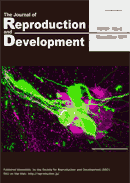Volume 57, Issue 4
August
Displaying 1-17 of 17 articles from this issue
- |<
- <
- 1
- >
- >|
Original Article
-
Article type: -Original Article-
2011Volume 57Issue 4 Pages 437-443
Published: 2011
Released on J-STAGE: September 06, 2011
Advance online publication: April 05, 2011Download PDF (216K) -
Article type: -Original Article-
2011Volume 57Issue 4 Pages 444-449
Published: 2011
Released on J-STAGE: September 06, 2011
Advance online publication: March 08, 2011Download PDF (370K) -
Article type: -Original Article-
2011Volume 57Issue 4 Pages 450-456
Published: 2011
Released on J-STAGE: September 06, 2011
Advance online publication: April 09, 2011Download PDF (199K) -
Localization of a Novel RNA-binding Protein, SKIV2L2, to the Nucleus in the Round Spermatids of MiceArticle type: -Original Article-
2011Volume 57Issue 4 Pages 457-467
Published: 2011
Released on J-STAGE: September 06, 2011
Advance online publication: April 05, 2011Download PDF (1074K) -
Article type: -Original Article-
2011Volume 57Issue 4 Pages 468-474
Published: 2011
Released on J-STAGE: September 06, 2011
Advance online publication: April 19, 2011Download PDF (291K) -
Article type: -Original Article-
2011Volume 57Issue 4 Pages 475-480
Published: 2011
Released on J-STAGE: September 06, 2011
Advance online publication: April 19, 2011Download PDF (418K) -
Article type: -Original Article-
2011Volume 57Issue 4 Pages 481-491
Published: 2011
Released on J-STAGE: September 06, 2011
Advance online publication: April 09, 2011Download PDF (360K) -
Article type: -Original Article-
2011Volume 57Issue 4 Pages 492-499
Published: 2011
Released on J-STAGE: September 06, 2011
Advance online publication: April 26, 2011Download PDF (464K) -
Article type: -Original Article-
2011Volume 57Issue 4 Pages 500-506
Published: 2011
Released on J-STAGE: September 06, 2011
Advance online publication: May 18, 2011Download PDF (283K) -
Article type: -Original Article-
2011Volume 57Issue 4 Pages 507-517
Published: 2011
Released on J-STAGE: September 06, 2011
Advance online publication: May 23, 2011Download PDF (695K) -
Article type: -Original Article-
2011Volume 57Issue 4 Pages 518-525
Published: 2011
Released on J-STAGE: September 06, 2011
Advance online publication: May 23, 2011Download PDF (338K) -
Article type: -Original Article-
2011Volume 57Issue 4 Pages 526-533
Published: 2011
Released on J-STAGE: September 06, 2011
Advance online publication: May 23, 2011Download PDF (476K)
Technology Report
-
Article type: -Technology Report-
2011Volume 57Issue 4 Pages 534-538
Published: 2011
Released on J-STAGE: September 06, 2011
Advance online publication: March 26, 2011Download PDF (120K) -
Article type: -Technology Report-
2011Volume 57Issue 4 Pages 539-542
Published: 2011
Released on J-STAGE: September 06, 2011
Advance online publication: April 30, 2011Download PDF (383K) -
Article type: -Technology Report-
2011Volume 57Issue 4 Pages 543-546
Published: 2011
Released on J-STAGE: September 06, 2011
Advance online publication: May 23, 2011Download PDF (416K) -
Article type: -Technology Report-
2011Volume 57Issue 4 Pages 547-550
Published: 2011
Released on J-STAGE: September 06, 2011
Advance online publication: May 23, 2011Download PDF (104K) -
Article type: -Technology Report-
2011Volume 57Issue 4 Pages 551-555
Published: 2011
Released on J-STAGE: September 06, 2011
Advance online publication: April 30, 2011Download PDF (322K)
- |<
- <
- 1
- >
- >|
